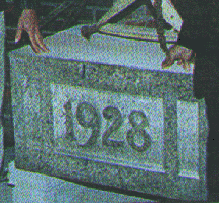1990's The Digital Studio

1991
FCC approves expansion of the AM broadcast band. The change adds from 1605-1705 kHz.
1992
As of November 30th, 1992 the FCC reports 4961 AM stations, 4766 commercial FM stations, and 1585 Educational FM stations, for a total of 11,312 radio stations on the air in the United States. There are also 1509 television stations broadcasting.
New station ownership rules go into effect - a single group may now own up to 18 AM and 18 FM broadcast stations.
The Digital Compact Cassette (DCC) is introduced to the consumer market.
'USA Digital Radio' conducts its first 'on-air' tests of their in band on channel A.M. digital audio broadcasting in Cincinnati, OH.

1993
FCC selects the Motorola C-QUAM system of AM stereo transmission as the US standard - Ten Years after AM stereo was first authorized. The lack of an approved standard greatly hindered the development of this mode of broadcasting.
The U.S. Congress instructs the FCC to begin collecting "Regulatory Fee's" from broadcast stations. To ease the pain...you may pay the FCC with your credit card.
1994
The top format for U.S. Commercial radio is Country - 2642 stations.
Adult Contemporary is number two with 1784, News/Talk has 1028, and Religious stations are fourth with 926 stations.
Rock is programmed by 721, Oldies 714, Spanish/Ethnic has 470 and Adult Standards is programmed by 435.
Rounding out the top ten are Top-40 with 358 and Urban with 328.
Denmark begins on air testing of the Eureka 147 method of Digital Audio Broadcasting on 237 MHz.
The first allotment plan for the expanded AM band is released.
1995
The FCC revises rules to allow unattended operation of broadcast stations.
The first broadcast station in the expanded band signs on. WJDM - Elizabeth NJ at 1660 kHz.
The FCC allocates spectrum for a new satellite delivered Digital Audio Radio Service (DARS) in the 2310 to 2360 megahertz band.
The average U.S. home has 5.6 radio receivers.
There are an estimated 584,900,000 radio receivers in use.
The BBC - British Broadcasting Corporation - begins introductory DAB service.
1996
 A Time Capsule placed by Arthur Atwater-Kent in 1929 is opened in Philadelphia, as the building which was his manufacturing plant is to be demolished. Inside it are newspapers with headlines of the Lindberg kidnaping, note cards from the dedication speech, and an AK55 radio taken fresh off the assembly line in 1929.
A Time Capsule placed by Arthur Atwater-Kent in 1929 is opened in Philadelphia, as the building which was his manufacturing plant is to be demolished. Inside it are newspapers with headlines of the Lindberg kidnaping, note cards from the dedication speech, and an AK55 radio taken fresh off the assembly line in 1929.FCC adopts a standard for High Definition T.V. (HDTV)
Digital Audio Broadcasting begins in Sweden from four transmitters utilizing Eureka 147.
The U.S. Congress mandates that the FCC collect over 152 million dollars in "regulatory Fee's" from broadcasters in 1997.
1997
January 1st the E.A.S., Emergency Alert System goes 'on-line' in broadcast stations - replacing the aging technology of the E.B.S. - the Emergency Broadcasting System.
Sample E.A.S. Message

Mars Pathfinder sends images to Earth.
The FCC issues only two licenses for Digital Audio Radio Service (DARS) - by Auction! Only the four original applicants from 1992 are allowed to bid. American Mobile Radio Corporation and Satellite CD Radio, Inc. are the winners.
In comments on the action, the FCC said it "could not entirely rule out the possibility of a major adverse impact" to traditional local broadcasters.
2000

Return to the Home Page